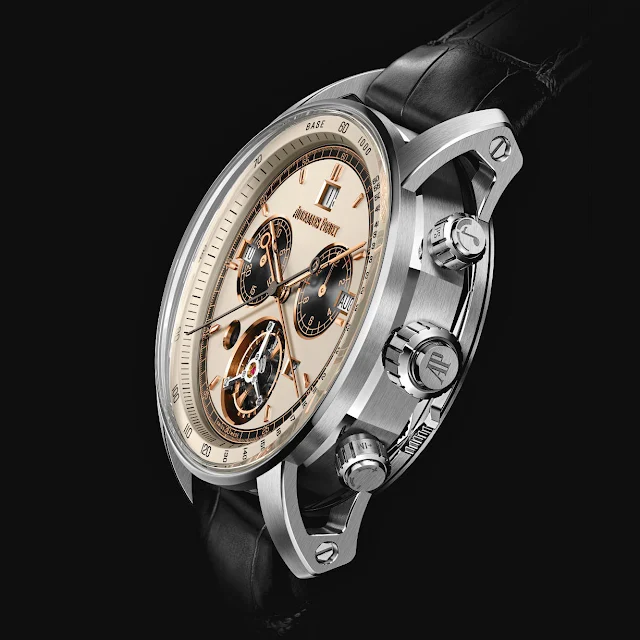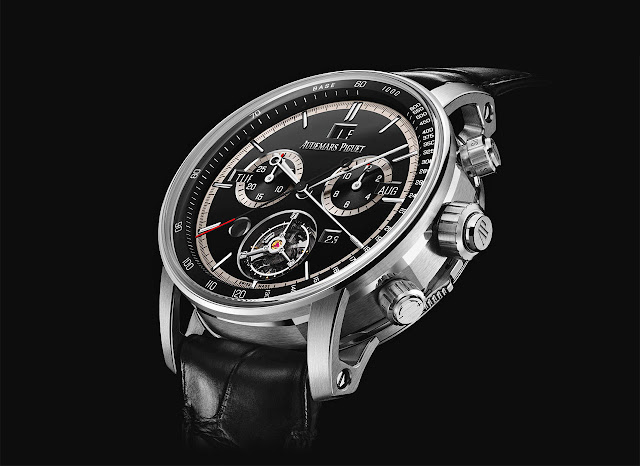Audemars Piguet unveiled the Code 11.59 Ultra-Complication Universelle RD#4. Fuly explained with pictures and price
Audemars Piguet unveiled its first ultra-complicated selfwinding wristwatch housed in a Code 11.59 collection case.
The new Code 11.59 Ultra-Complication Universelle RD#4 is powered by a movement, the Calibre 1000, which counts over 1,100 components, incorporating 40 functions and combining sophisticated complications such as a Grande Sonnerie Supersonnerie, a minute repeater, a perpetual calendar, a split-seconds flyback chronograph and a flying tourbillon.
This model was built on the Manufacture’s three recent R&D innovations – the Supersonnerie technology unveiled in 2015 (RD#1), the ultra-thin perpetual calendar movement launched in 2018 (RD#2) and the oscillator with increased amplitude premiered on the two Royal Oak Selfwinding Flying Tourbillon Extra-Thin RD#3 models released in 2022.
While the case has retained the ergonomic curvature and design codes of the Code 11.59 collection, its proportions have been slightly adapted to fit this ultra-complicated mechanism. Despite its complexity, the movement is just 34.3 mm in diameter and 8.75 mm in thickness making it possible to keep the case size of the Ultra-Complication Universelle RD#4 down to 42 mm in diameter and 15.55 mm in thickness.
One of the major technical developments consisted in simplifying the use of the functions for the wearer by reducing the high number of pushers and correctors usually found on highly complicated timepieces to three crowns and three push-pieces.
The push-pieces have been integrated to the case’s left side. The top one starts the minute repeater function, the other two pushers respectively serve to correct the moon and day indications.
On the right side of the case, three crowns with coaxial pushers allow the wearer to wind the watch, set the time and date with the central crown and select the chiming mode (Grande Sonnerie, Petite Sonnerie or silence mode).
The flyback chronograph can be started/stopped using the supercrown at 2 o’clock and reset with the other supercrown at 4 o'clock. This latter crown also enables the forward or backward correction of the month. In addition, the crown automatically returns to its neutral position after rotating it (up to 70°) in either direction. A complex security system prevents misuse.
Small symbols engraved on each crown and push-piece remind the wearer of their respective functions.
The Code 11.59 Ultra-Complication Universelle RD#4 combines a Grande Sonnerie with the patented Supersonnerie technology introduced by Audemars Piguet in 2015. A Grande Sonnerie timepiece strikes the hours and every quarter hour by passing (repeating the hour before the quarter every time), without any involvement from the wearer. In the Petite Sonnerie position, the watch chimes the hours only, while the automatic chiming is deactivated in the silent mode. Additionally, the wearer can activate the minute repeater mechanism at any time via the dedicated push-piece located at 10 o’clock. To optimise energy management and distribution, the timepiece’s chiming functions are fed by a dedicated barrel that is wound by the movement of the wrist, alternately with the main barrel.
The added Supersonnerie mechanism grants this ultra-complicated wristwatch the acoustic power, sound quality and harmonic tone of older chiming timepieces. The gongs are no longer attached to the mainplate, but to a 0.6 mm sapphire crystal membrane acting as a soundboard that improves sound transmission. This Supersonnerie technology also provides a sharper tempo, as the hours and minutes chime without interruption when there is no quarter chiming sequence.
The caseback can be opened by a thin "secret" cover which also features apertures on the side to let air through and boost sound amplification, especially when the watch sits on the wrist.
The perpetual calendar mechanism has been conceived to optimise the display and use of the calendar functions, while taking as little space as possible. To do so, Calibre 1000 builds on the patented innovations of Calibre 5133 premiered in 2018 with the release of the Royal Oak Selfwinding Perpetual Calendar Ultra-Thin RD#2 prototype, which merged the perpetual calendar functions onto one single level. The end-of-the-month cam has been similarly integrated to the date wheel, while the month cam has been combined to the month wheel. The large date at 12 o’clock and the two digit year indication at 4 o’clock replacing the traditional leap year indication, complement the perpetual calendar mechanism.
The day and moon phases can be corrected thanks to two dedicated pushers located on the left side of the case, while the reversible date system enables to move the date forwards and backwards by turning the crown at 3 o’clock in either direction. The month, too, can be adjusted forwards or backwards via the “supercrown” at 4 o’clock.
This perpetual calendar mechanism advances the day, date and year automatically taking into account the number of days per months, leap years included, as well as the 100-year correction normally required in traditional Gregorian perpetual calendars. No manual adjustment is therefore required before the year 2400.
The instant-jump astronomical moon system uses two concentric discs, on which six different moon positions are printed, that combine to form ten images representing the waxing and waning stages between the new and full moon. Assuming that the watch has been kept fully wound, this moonphase display will require manual correction every 122 years.
One of the major innovations for saving space and keep the size of the movement down was the integration of the split-seconds chronograph mechanism within the thickness of the central rotor’s ball bearing. By merging two systems usually superposed, Audemars Piguet engineers reduced the movement’s thickness by 1.1 mm, while also revealing the mechanism when the user opens the watch’s “secret” cover.
The Code 11.59 by Audemars Piguet Ultra-Complication Universelle RD#4 is endowed with a flying tourbillon at 6 o’clock that completes a revolution every minute to correct the effect of gravity on the watch’s accuracy. To optimise the flow of energy and prevent the watch from stopping when all functions are working, the Calibre 1000 relies on a new oscillator with increased amplitude that was premiered in 2022 on the two RD#3 Royal Oak Selfwinding Flying Tourbillon Extra-Thin models.
This solution necessitated to increase the energy of the wristwatch’s base movement, while keeping a 3 Hz frequency (21,600 vibrations per hour), ideal to appreciate the beating of the flying tourbillon on the dial side. To this end, a larger main barrel was developed to power the hands, as well as the chronograph and calendar functions, while, as explained before, the chiming complications are fed by a dedicated barrel. Thanks to this approach, the watch offers some 60 hours of autonomy when not on the wrist, depending if the functions are activated.
Four variations of the model will be introduced in 2023:
- white gold case with opaline black galvanic gold dial (ref. 26398BC.OO.D002CR.01);
- white gold case with opaline beige PVD gold dial and black counters (ref. 26398BC.OO.D002CR.04);
- white gold case with an openworked dial (ref. 26398BC.OO.D002CR.02);
- pink gold case with an openworked dial (ref. 26398OR.OO.D002CR.01).
The price of the Audemars Piguet Code 11.59 Ultra-Complication Universelle RD#4 is CHF 1,450,000 with solid dials and CHF 1,600,000 with openworked ones. audemarspiguet.com

























Nice!
ReplyDelete